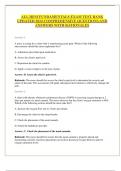Exam (elaborations)
ALL HESI FUNDAMENTALS EXAM TEST BANK UPDATED 2024 COMPREHENSIVE QUESTIONS AND ANSWERS WITH RATIONALES
- Course
- Institution
ALL HESI FUNDAMENTALS EXAM TEST BANK UPDATED 2024 COMPREHENSIVE QUESTIONS AND ANSWERS WITH RATIONALES
[Show more]



